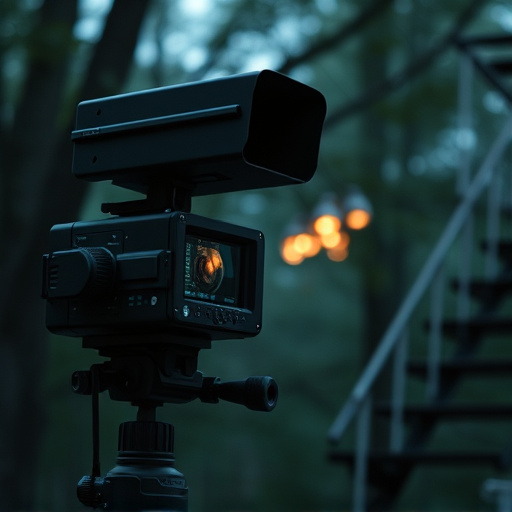Battery-operated hidden childcare cameras, though offering remote monitoring and peace of mind for parents, spark debate due to privacy and safety concerns. These devices, leveraging advanced optical sensors for high-resolution footage, impact a child's development and face legal scrutiny regarding privacy rights in homes and childcare facilities. Professional installation ensures optimal performance while maintaining discretion. However, ethical dilemmas arise from their use in sensitive settings like schools and daycares, clashing with privacy protections. Alternative methods prioritizing transparency and consent are recommended to balance supervision and respect for individual privacy.
Hidden cameras, particularly battery-operated models, offer parents a crucial tool for monitoring their children’s safety in childcare settings. This article delves into the world of optical sensor detection, exploring advanced methods and professional installation techniques for these unassuming devices. From understanding the capabilities of battery-operated hidden childcare cameras to navigating legal and ethical boundaries, we provide an insightful guide for parents considering this sensitive yet potentially life-saving surveillance method.
- Understanding Battery-Operated Hidden Cameras: A Parent's Perspective
- The Role of Optical Sensor Detection in Childcare Surveillance
- Professional Installation and Setting Up the Devices Effectively
- Advanced Methods for Invisible Monitoring with Optical Sensors
- Legal and Ethical Considerations for Using Hidden Cameras in Childcare
Understanding Battery-Operated Hidden Cameras: A Parent's Perspective
Hidden cameras, particularly those powered by batteries, have become a subject of heightened concern for parents in today’s digital age. Battery-operated hidden childcare cameras are often discreetly placed to monitor activities in homes, daycares, or other child-care settings. This technology raises both safety and privacy issues from the perspective of parents, who must balance the benefits of surveillance with potential risks to their children’s trust and autonomy.
As a parent, understanding how these devices operate is crucial. Battery-operated hidden cameras can be highly advanced, featuring motion sensors, night vision capabilities, and even two-way audio. While they offer peace of mind by enabling remote monitoring, parents should also be aware of the potential drawbacks. The constant awareness and surveillance can impact a child’s natural development, and there are legal considerations regarding privacy rights in homes and childcare facilities.
The Role of Optical Sensor Detection in Childcare Surveillance
Optical sensor detection plays a pivotal role in enhancing childcare surveillance, offering parents and caregivers peace of mind in the absence of direct supervision. Hidden childcare cameras equipped with optical sensors can capture high-resolution footage discreetly, ensuring every moment is recorded without intruding on children’s activities. These battery-operated hidden childcare cameras are versatile tools that can be strategically placed in various settings, from playrooms to nap areas, allowing caregivers to monitor behavior, ensure safety, and document developmental milestones remotely.
The sensors’ ability to detect movement and light changes enables them to activate recording only when necessary, optimizing battery life and storage capacity. This targeted activation ensures that sensitive information is captured while maintaining privacy for both children and caregivers. With optical sensor detection, parents can trust that their children are in capable hands, even when they’re not physically present.
Professional Installation and Setting Up the Devices Effectively
Professional installation and proper device setup are paramount for optimal performance of battery-operated hidden childcare cameras. Expert technicians ensure each camera is strategically placed, capturing all necessary areas while maintaining a discreet profile to avoid disturbing children or their activities. The process involves meticulous planning, considering factors like lighting conditions, camera angle, and zoom capabilities to guarantee clear and detailed footage.
Effective setup includes configuring the devices’ settings for ideal sensitivity and resolution. This may involve adjusting motion detection parameters, night vision capabilities, and recording frequency to meet specific monitoring needs. A well-set up hidden camera system ensures continuous, high-quality surveillance, providing peace of mind for parents and caregivers.
Advanced Methods for Invisible Monitoring with Optical Sensors
In today’s digital age, advanced optical sensor technology has paved the way for innovative monitoring solutions, particularly in invisible childcare surveillance. Battery-operated hidden cameras, seamlessly integrated into various objects, offer a discreet yet powerful tool for parents seeking peace of mind. These sophisticated devices utilize optical sensors to capture high-resolution images and videos without drawing attention, ensuring a safe and unintrusive environment for children.
Optical sensor detection sweeps employ cutting-edge techniques to detect even the slightest movements or changes in light patterns. By analyzing these subtle signals, the hidden cameras can activate discreetly, providing real-time monitoring from afar. This technology revolutionizes childcare safety, allowing parents to remotely supervise their little ones’ activities, especially in settings like daycares, playgroups, or private homes where constant human supervision might not be feasible.
Legal and Ethical Considerations for Using Hidden Cameras in Childcare
The use of hidden cameras in childcare settings, particularly those powered by batteries, raises significant legal and ethical concerns. While some parents may opt for battery-operated hidden childcare cameras to ensure the safety and well-being of their children, this practice intersects with privacy rights and potential legal implications. Many countries have strict regulations regarding surveillance, especially in sensitive environments like schools and daycares, to protect the privacy of individuals.
Ethically, the presence of hidden cameras can create an atmosphere of distrust and invade the personal space of both children and staff. It’s essential to consider alternative methods for monitoring childcare facilities, such as open-circuit television (CCTV) systems or periodic checks by trained professionals, that strike a balance between supervision and respect for privacy. Parents should also be transparent about surveillance measures and seek consent from caregivers and, where applicable, the children themselves, ensuring everyone understands their rights.
Optical sensor detection techniques have revolutionized battery-operated hidden childcare cameras, offering parents and caregivers advanced monitoring solutions. By understanding the technology behind these devices, professionally installing them, and adhering to legal and ethical guidelines, it’s possible to ensure a safe and secure environment for children. These innovative methods provide peace of mind while navigating the intricate balance between privacy and surveillance in childcare settings.
